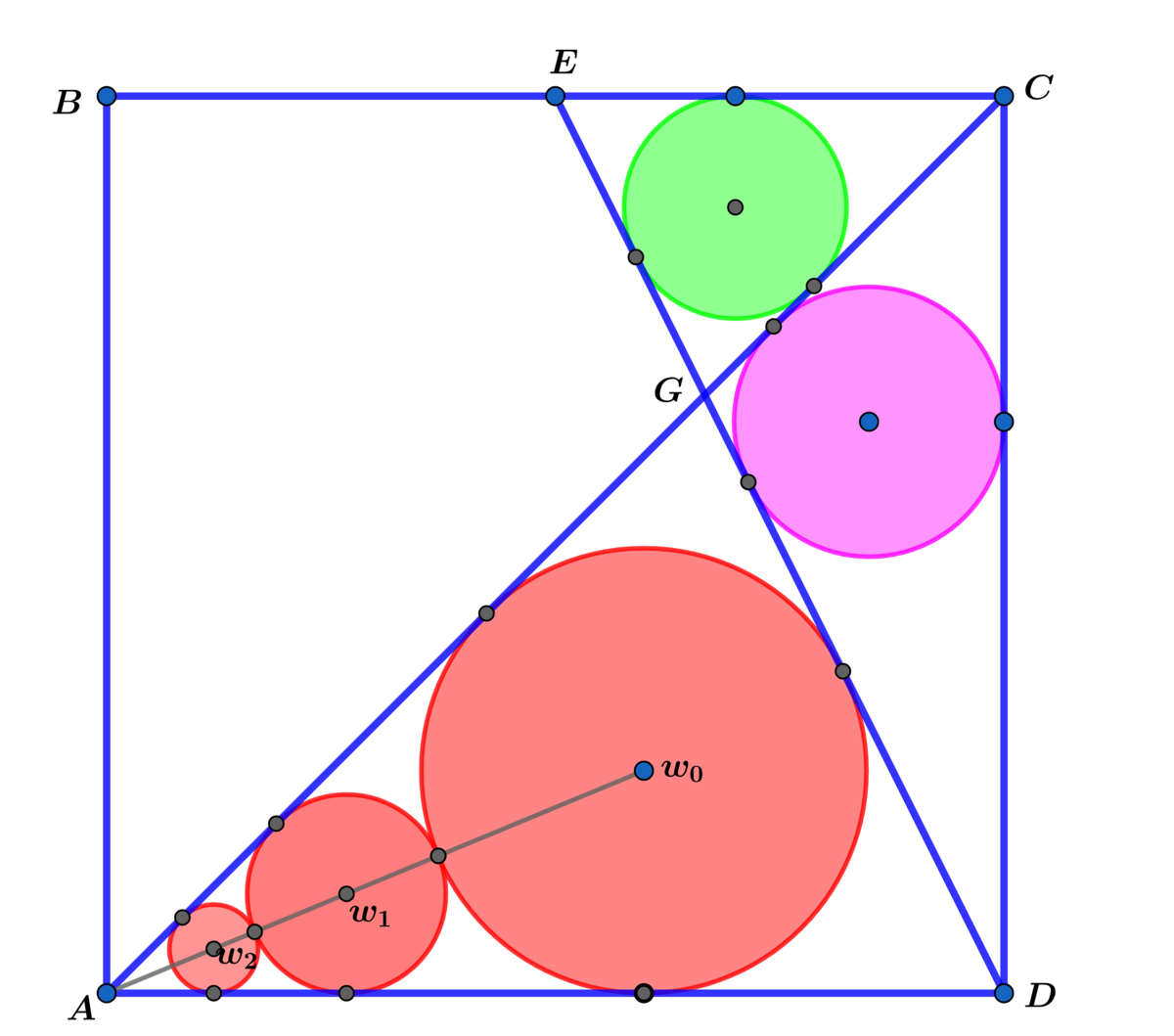Everywhere there's circles!

In square with side length , is a midpoint of .
Extend the red circles above to an infinite number of red circles. For each integer , circle is tangent to and tangent to diagonal and and the green and pink circles are tangent to and diagonal as shown above and tangent to and respectively.
Let be the sum of the areas of all the circles in the above diagram.
Find .
The answer is 0.3606644316482196.
This section requires Javascript.
You are seeing this because something didn't load right. We suggest you, (a) try
refreshing the page, (b) enabling javascript if it is disabled on your browser and,
finally, (c)
loading the
non-javascript version of this page
. We're sorry about the hassle.
For red circle with radius r :
For A C : y = x and m E D = − 2 ⟹ y = − 2 x + 2 a ⟹ x = y = 3 2 a
⟹ G ( 3 2 a , 3 2 a ) ⟹ A G = 3 2 2 a and G D = 3 5 a
⟹ A △ A G D = 2 1 ( a ) ( 3 2 a ) = 3 a 2 = 2 a r ( 3 3 + 2 2 + 5 ) ⟹
2 a 2 − ( 3 + 2 2 + 5 ) a r = 0 ⟹ a ( 2 a − ( 3 + 2 2 + 5 ) r ) = 0 and
a = 0 ⟹ r = 5 + 2 2 + 3 2 a
For green circle: with radius r 2 .
h △ E G C = a − 2 2 a = 3 a , E G = 6 5 a and G C = 3 2 a ⟹
A △ E G C = 2 1 ( 2 a ) ( 3 a ) = 1 2 a 2 = 2 1 ( a r 2 ) ( 6 5 + 2 2 + 3 ) ⟹
a ( a − ( 5 + 2 2 + 3 ) r 2 ) = 0 and a = 0 ⟹ r 2 = 5 + 2 2 + 3 a
Similarly using the same method for the pink circle with radius r 3 we have:
r 3 = 5 + 2 + 3 a
Let R 1 = r = 5 + 2 2 + 3 2 a
O w 0 = 4 + 2 2 R 1
△ O A 1 w 0 ∼ △ w 1 A 2 w 0 ⟹ R 1 4 + 2 2 R 1 = R 1 − R 2 R 1 + R 2 ⟹
( 4 + 2 2 − 1 ) R 1 = ( 4 + 2 2 + 1 ) R 2 ⟹ R 2 = 4 + 2 2 + 1 4 + 2 2 − 1 R 1
R 3 = 4 + 2 2 + 1 4 + 2 2 − 1 R 2 = ( 4 + 2 2 + 1 4 + 2 2 − 1 ) 2 R 1
In General: R n = ( 4 + 2 2 + 1 4 + 2 2 − 1 ) n − 1 R 1
⟹ A n = π R n 2 = π R 1 2 ( ( 4 + 2 2 + 1 4 + 2 2 − 1 ) 2 ) n − 1
⟹ A = ∑ n = 1 ∞ A n = π R 1 2 ∑ n = 1 ∞ ( ( 4 + 2 2 + 1 4 + 2 2 − 1 ) 2 ) n − 1
= 4 4 + 2 2 ( 4 + 2 2 + 1 ) 2 π R 1 2 ⟹
A A B C D A = 4 + 2 2 ( 5 + 2 2 + 3 ) 2 ( 4 + 2 2 + 1 ) 2 ≈ 0 . 2 4 1 3 2 4 4 7 2 3 2 5 3 2 4 4
and A A B C D A ∗ = ( r 2 2 + r 3 2 ) π = ( ( 5 + 2 2 + 3 1 ) 2 + ( 5 + 2 + 3 1 ) 2 ) π
≈ 0 . 1 1 9 3 3 9 9 5 9 3 2 2 8 9 5 2
⟹ A A B C D S = A A B C D A + A ∗ ≈ 0 . 3 6 0 6 6 4 4 3 1 6 4 8 2 1 9 6